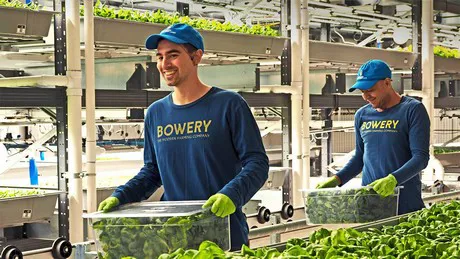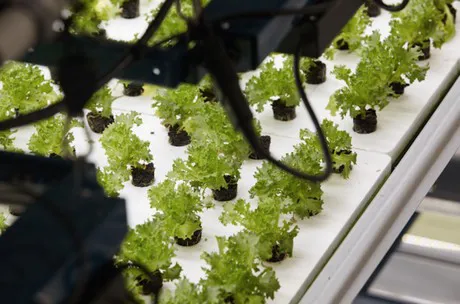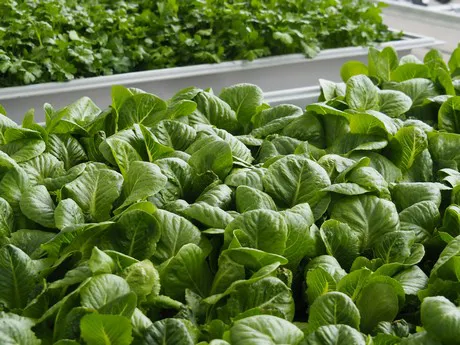"The mistake many in our industry make is to attribute the success of indoor farming solely to LED. LED makes indoor farming viable. But if you want to make indoor farming scalable, you have to think in trends that are happening in robotics, automation, computer vision and machine learning." So says Irving Fain, CEO with Bowery Farming.
Yesterday the company announced a $90 million funding round, led by GV (formerly Google Ventures). Additional investors in this round include Temasek (the global investment company headquartered in Singapore), Dara Khosrowshahi (CEO of Uber), David Barber’s fund Almanac, First Round Capital, GGV Capital and General Catalyst. What's their secret? “Bowery Farming isn’t just about focusing on growing indoors, it is also about producing an economical product by using technology.”
Indoor farming
Indoor Farming is a hot topic these days. With on one hand companies going through the roof and on the other hand companies having to give up their activities, there's obviously both opportunities as well as major challenges in the industry. "Overall it has been an exciting time for our industry of indoor farming. We work in ways that ten years ago weren’t possible," Irving Fain with Bowery Farming explains. The company opened up their first farm in 2017 in New York. "Indoor farming is not just putting up four walls. It is controlling the environment to provide the growing population in cities with fresh food.”
To Bowery Farming, the line between techniques and producing food is a thin one. In totally controlled environments they are able to grow consistently, pesticide-free and year-round, regardless of the climate. “Given the level of control, we are not only growing twice as fast as the field, we are getting more yield of every crop cycle, as well as more crop cycles per year than the field does. We can grow a lot faster while saving over 95% of water.” Then there’s traceability, producing local and food safety – especially in these days an important reason to keep an eye out for indoor farms. Bowery’s farms are SQF certified, the highest level of food safety, and they implement stringent food safety policies so that retail partners and customers can be confident purchasing produce that has gone through the highest levels of food safety and quality testing.
Want to take a peek into the farm? Bowery's head of R&D and BoweryOS, Henry Sztul, sat down with Fluence Bioengineering to share how they are able to cultivate food 365 days a year in a highly productive and efficient way.
Software control
One of the unique points of Bowery Farming specifically is their own software control system: BoweryOS. “We are not only a farm, but also a tech company. We’ve built a proprietary software system that uses automation, machine learning and vision systems and sensors to monitor our plants 24/7 and collect millions of data points. This allows us to constantly iterate on each varietal, tweak flavor profiles, provide each crop exactly what it needs to thrive, and harvest each crop at the exact right time. BoweryOS will also tell the farmer what to do, when and how, which means that we don’t necessarily need to hire experienced farmers.” According to Irving, the lack of need for skilled labour is one of the points that will assure Bowery Farming of a future not touched by the troubles many indoor farms are in.

Viable indoor farming
“We honor the innovation that’s been going on for decades in places like the Netherlands. The Dutch growers have been innovators in agriculture for a long time. With what we are building here, we take the knowledge of all those years and innovate on top of that,” says Irving.
As an example, he recalls the developments in LED lighting, making indoor farming possible in a way that hasn’t been before. “Part of the indoor farming developments occurred thanks to LED. LEDS were expensive for a long time. In the last seven years they have dropped in cost by 85% and doubled in efficiency. And even more interesting: they are dropping again and will become twice as efficient as today,” he confirms. But if you want to make a solid business case, indoor farming has to be scalable. Therefore you have to think in trends that are happening in robotics, automation, computer vision and machine learning. These are the things that allow the economics of the business to change in various ways. Bowery Farming isn’t just about focusing on growing indoors, it is also about producing an economic product by using technology.”


Proof of concept
With the first Bowery farm, Irving has delivered his proof of concept in the last couple of years, both tech wise as in the market. The company supplies to a number of retail outlets like Whole Foods and has increased distribution with the opening of the new farm. “Together we’re expanding in the market: we deliver to a number of Whole Foods and Foragers in the area and continue to grow. We’ve also opened up some foodservice partnerships with Temple Court, sweetgreen and Dig Inn in the New York area.”
According to Irving, the growth isn’t over. “Our biggest challenge is to get people to really believe in this industry and in the importance of what we’re doing.” This might be pretty easy with the current circumstances – the E.coli outbreak. But there’s more, Irving explains. “Thanks to our efficient use of supplies and nearby growing, we’re offering a product that’s premium in terms of quality, but pricewise equivalent to field produce.”

Selling the system?
Even though he’s currently occupied fully with the recent opening of their new farm, the eyes at Bowery are set on the horizon. “The opening of our second farm is just the beginning. The roadmap is enormous, we have plenty more opportunities. We have a lot of interest both from consumer and retailer. Although we focus on succeeding in the New York market, the growing popularity of people moving into cities is not only an issue in the US but everywhere. Ultimately I see Bowery Farming all around the world using our technology to provide fresh food to urban environments.”
The recent $90 million funding is to contribute to this. Prior to this round, Bowery raised $27.5 million from investors. Bowery plans to use the capital to scale their operation in new cities across the country and open multiple farms by the end of 2019. This funding will also enable them to continue growing the team, investing in technology and innovation across the company.
Does he consider expanding by selling their technique instead of opening up new farms on their own? For now the answer is no. “For now there is so much learning to be done. We fully focus on building and designing to put us in a better position.” He explains why that remains important. “We are a technology company, but our product is food.” It sounds simple, but to Irving it is important to not lose sight on that. “At the end of the day we are growing food for people. They bring it home to their families, are at the dinner table. That’s a topic we should never let out of sight. While we are developing all this great technology, the end result has to be good food.”
For more information:
Bowery Farming
https://boweryfarming.com/
contact@boweryfarming.com
